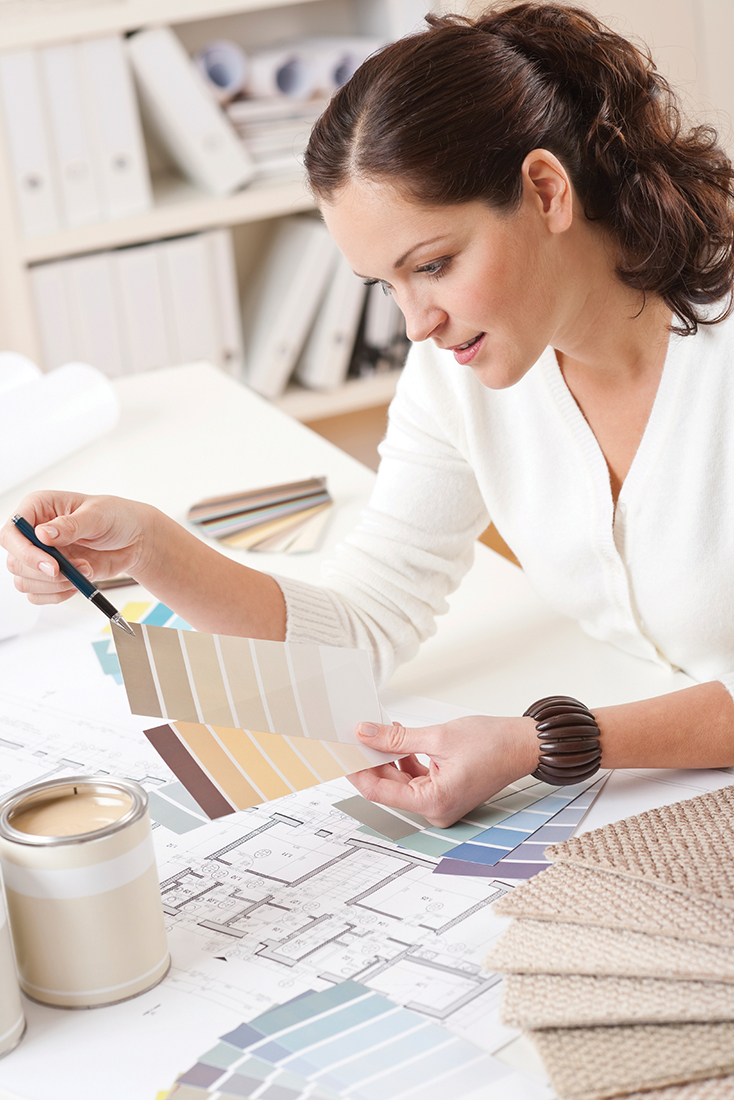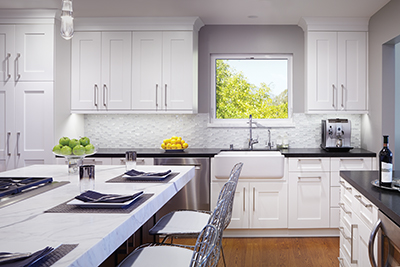
OUR HOMES DO more than provide shelter. They reflect the needs, personalities and lifestyles of the people who inhabit them. So unless you’ve designed your place from scratch, there’s likely a project or 20 you’re contemplating to make your space more fully your own. To inspire you, we asked local experts for the latest and greatest home renovation trends.
Cabinetry
“White, white, and more white — that’s what people are asking for in kitchen cabinets these days,” says Sean Kelly, owner of Lamperti Contracting and Design in San Rafael. Of course, white means many things to many people. And even within this color (or lack of color) palette, a subtrend is emerging. “People are drawn to a finish called dry brush,” says Kelly. This process adds depth and texture to the cabinet. Kelly has also seen an uptick in people choosing high-sheen smoked glass cabinets. “It’s a great modern look but it definitely won’t hide fingerprints,” he says.
Mixed Media
For kitchen and bath fixtures the rule of thumb has always been to pick one finish and use it consistently. In other words, a chrome shower head should be color-matched with sink and tub fixtures. In 2015, however, homeowners are learning that blending two finishes can actually make a room more dramatic. “I see a lot of mixing of shiny and matte finishes,” says Holly Kopman, owner of Holly A. Kopman Interior Design in Sausalito. And it’s not just silver tones anymore. “Gold tones are coming back,” she says. “People still kind of like the brushed silver for door hardware, but they’re mixing rose gold and dark bronzes in both kitchens and bathrooms.”
Walls
Gray continues to be an important part of the new color palette. However, the monochromatic is losing appeal; people are moving toward bright accent hues. “Remodelers are also using wallpaper in less traditional applications. We’re seeing it being used on ceilings, inside bookcases, closet doors, interiors of closets and accent walls,” says Kopman. “I am also seeing modern twists on traditional themes.” Some examples: skull toile, damask in edgy colors and Warhol flowers in neon colors.
Flooring
The love for hardwood floors shows no sign of waning. According to Kopman, oak is still a favorite material, with many choosing to stain with softer colors: “We’re getting away from the yellowing basketball court look and instead staining floors with a gray or white tone.” Remodelers are also favoring wide planks over skinny, and engineered wood floors, which used to be synonymous with lower quality, are now appearing in jobs at every price point. “It’s not necessarily the cheaper option, as you can now get veneers made with all sorts of exotic woods and finishes,” says Lamperti’s Kelly.
Bathrooms
A soaking tub and a walk-in shower are master bath features most remodeling homeowners would love to incorporate. But with the everescalating cost per square foot of Marin real estate, many don’t have the space to pull it off. There’s a solution, says Sheila Schmitz, editor of the design website and online community houzz.com: “We’re seeing Houzzers enclosing tubs inside their walk-in showers, making room for both in a smaller footprint.”
Clean Fuel
The economy may be recovering, but people are still gun-shy about overspending, so “sustainability projects have definitely taken a hit,” says Jeff Jungsten, president of Caletti Jungsten Construction in Mill Valley. That’s not to say owners aren’t making changes where they can. But big-ticket items like, say, solar panels may get put on the back burner: even if certain upgrades seem unaffordable now, some people are taking steps toward incorporating them later — spending a little extra to include conduits for future solar panels, for instance, or upgrading an electrical panel with an additional 50 amps to accommodate a charging station for a plug-in car. “If we are already in the area and it makes it cheaper in the long term to do, we should do it,” Jungsten explains.
Drought Abatement
Gone are the days when bathroom remodels include shower sprayers that hit you from every possible angle. On the upswing, however, are products like dual-f lush toilets, which can cut water use in half. Ditto for front-loading washing machines. “We almost never sell top-load washing machines anymore,” says John O’Meara, manager of Standards of Excellence, an appliance retailer in San Rafael. “Front loaders use about a fifth the amount of water, and people are mindful of that.” To that end, remodelers are also snapping up KitchenAid’s newest dishwasher, which uses only two-and-a-half gallons of water per cycle compared to the six to eight the average dishwasher consumes.
Lighting
Building codes in Marin have long encouraged homeowners to switch to energy-efficient bulbs, but few are fond of fluorescent lighting’s sterile glare. “City building inspectors would demand people use fluorescents in their kitchen, but everyone just pulled it out after inspection,” says Duane Johnson, president of the Novato-based Artistic Lighting and Electric. Fortunately, remodelers are finding the newer LED lights more palatable and are even embracing them, he notes: “It’s an easy upgrade, and you go from using 30 to 50 watts per bulb to 8.8.” Of course, nothing can replace the warm glow of incandescence. So Kopman’s clients usually agree to use canned LED lights for the perimeter of a room, then choose one decorative incandescent fixture as a focal point. “For this, I’ll still go back to traditional bulbs, because it’s such a soft warm light,” she says.
Coffee Bar
Coffee bars are gaining traction in kitchen designs, at a level of complexity that depends on the owner’s budget and space. It can be a simple closed cabinet with an electrical outlet for the Nespresso machine or a fancy built-in unit with continual water supply for brewing and a warming drawer for mugs. “Coffee bars are big right now,” Kopman confirms, with versions offered by desirable makers like Miele and Wolf. The latter is a particularly “sought-after brand,” Kelly says, “so it’s sure to make demand for these appliances stronger.”
App-Controlled Everything
With a smartphone and a few well-placed wireless devices, you can run your entire household from the comfort of the couch or during a business trip to Bangkok. And it appears that’s exactly what Marin folks are doing. “People are retrofitting their light switches so they can turn everything on or off without even getting out of bed,” Johnson says, and likewise manage thermostats, door locks and even the temperature of the pool or spa. “Just about every customer we have now utilizes smart technologies,” says Lee Rider, owner of Larkspur’s North Coast Pools and Spas. “If, for example, you decide you want to use your hot tub after work, you can turn the heat on with your smartphone and it’s ready to use when you get home.”
Steam Ovens
Priced between $1,200 and $3,300, steam ovens are a hot new kitchen appliance but won’t fit every remodeler’s budget. If you do have the means, it’s just the ticket for a high-end kitchen: it cooks faster, helps food retain nutrients and uses less energy than a traditional oven. “When you show people what it can do, they’re amazed,” says Standards’ O’Meara. “The easiest way to demonstrate this is to cook broccoli in a microwave and then in the steam oven. You can see the advantage immediately.”
This article originally appeared in Marin Magazine’s print edition under the headline: “Remodel Revelations“.

Dawn Margolis Denberg has worked as a professional journalist for 20 years. Her work has appeared in top publications, including Wired, Shape and Parenting. She has also written several books for children including, The Men in Black Agent’s Manual The Official Godzilla Movie Fact Book. And, most recently, an episodic audio series for Tales Untold.



